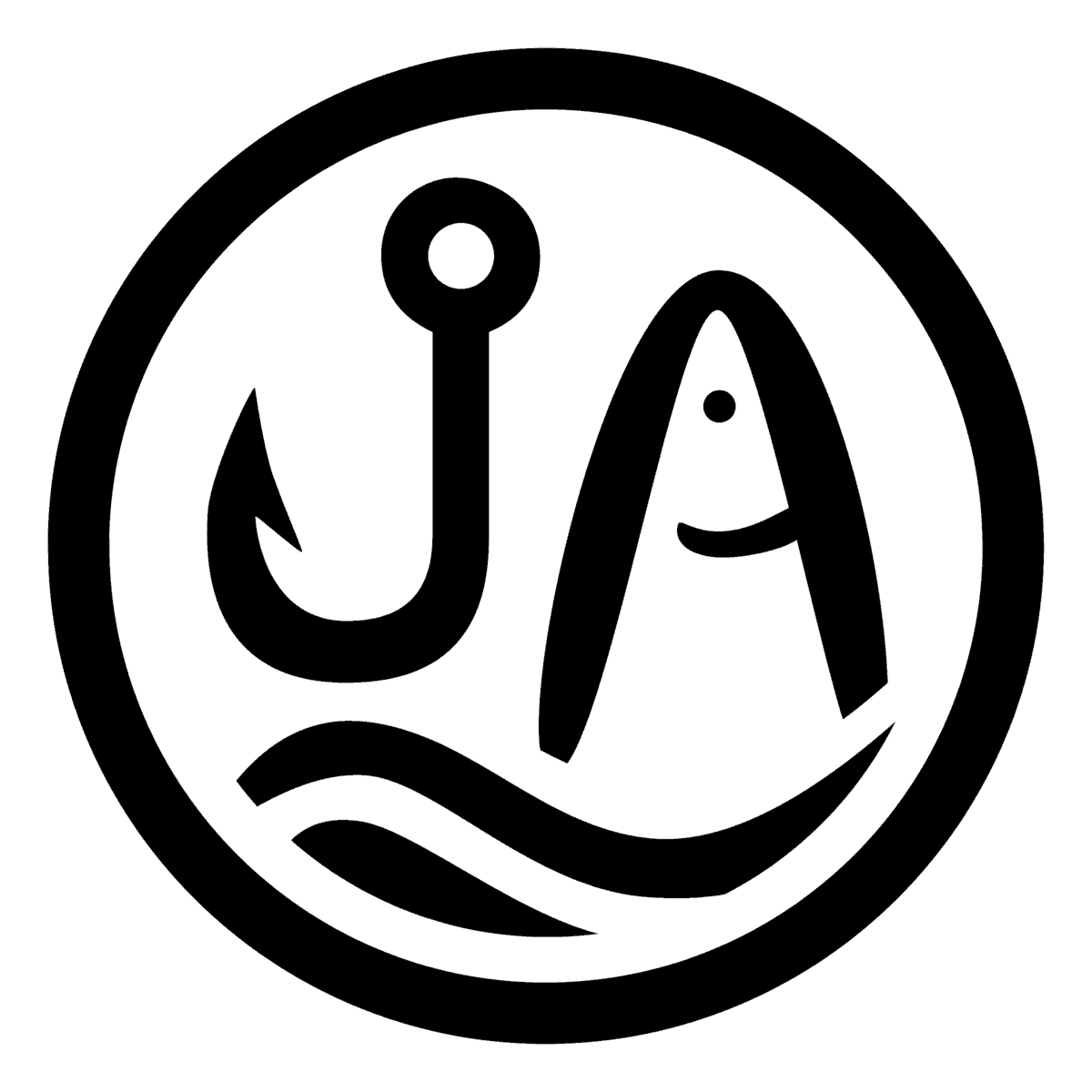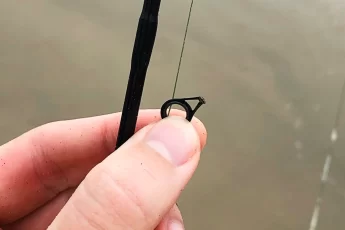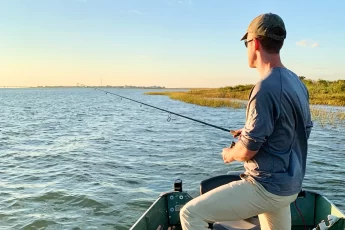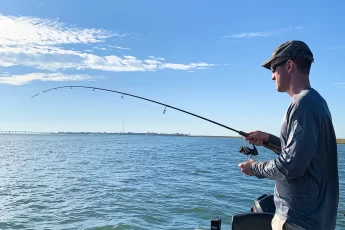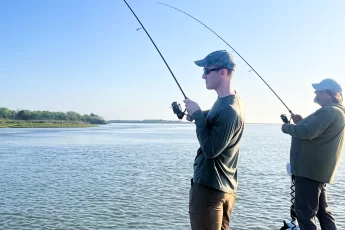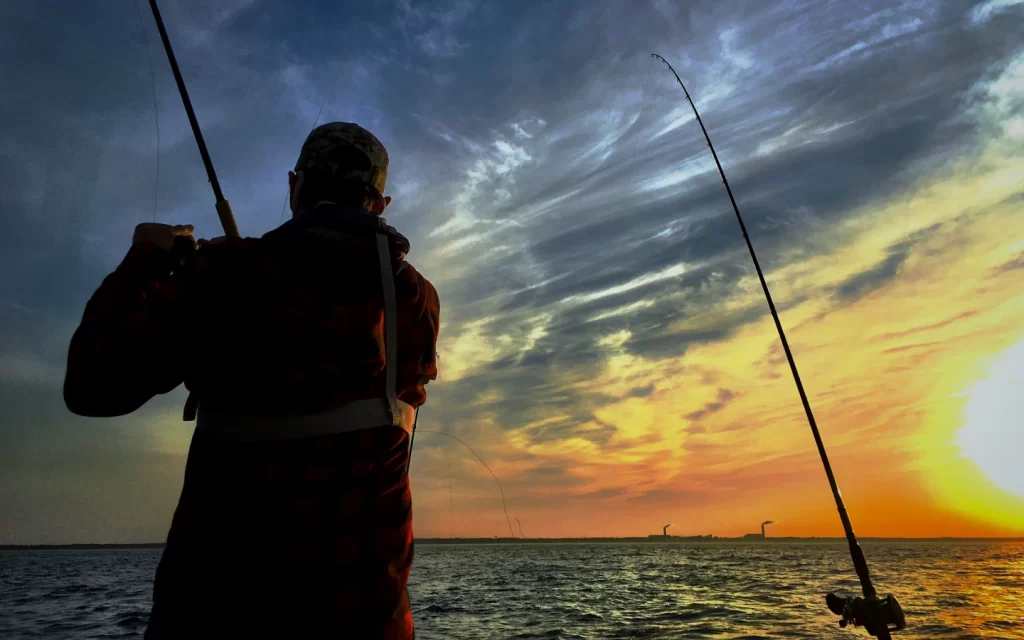
Updated 2/13/2024
The best trolling rods should be tough and reliable to handle the stresses of this unique fishing style.
Trolling is a popular fishing technique where baits suspended at various depths are pulled behind a moving boat. Anglers use trolling to target anything from walleye, salmon, trout, pike, and musky in freshwater to tuna, king mackerel, mahi mahi, and marlin in saltwater.
In this article, we take a look at the top trolling rods on the market, considering factors like price, performance, quality, and value.
Whether you are a beginner or an expert angler, these rods are sure to meet your needs and help land your next big catch!
*Disclosure: I only recommend products I would use myself and all opinions expressed here are my own. This post may contain affiliate links that at no additional cost to you, I may earn a small commission.
Our Top Picks
- Best Under $50: Okuma Classic Pro GLT Trolling Rod
- Best Under $100: Fiblink Trolling Rod with Ring Guides
- Best for Crankbaits: St. Croix Mojo Bass Casting Rod
- Best for Walleye: St. Croix Eyecon Trolling Rod
- Best for Saltwater: Fiblink Saltwater Offshore Heavy Trolling Rod with Roller Guides
- Best Combo: Penn Squall Lever Drag Conventional Rod & Reel Combo
The Best Trolling Rods
Read on to see our recommendations for the best trolling rods by category including best all-around, best for different price points, best for beginners, and more.
1. Okuma Classic Pro GLT Trolling Rod
- Length: 5’6″ to 10’6″
- Rod Material: Fiberglass
- Guides: Stainless Steel
- Grip: EVA Foam
- Warranty: 1 Year Manufacturing Defects
Pros:
- Budget friendly
- Beginner friendly with variants marketed for down rigger, striper umbrella, lake trolling, precision trolling, salmon, copper/leadcore, and dipsy diver
Our choice for the best trolling rod under $50 is the Okuma Classic Pro GLT Trolling Rod. These rods are purpose built for Great Lakes trolling for salmon, trout, and walleye. They are no-frills, purpose-built trolling rods that are welcome in almost any trolling spread.
We like that Okuma has Classic Pro GLT Rod variants marketed for down rigger, striper umbrella, lake trolling, precision trolling, salmon, copper/leadcore, and dipsy diver to help guide anglers towards the correct rod lengths, powers, and actions for specific trolling techniques.
For example, the down rigger version comes in comparatively long rod sizes from 7′ to 8’6″ because down rigger rods need to quickly pick-up when the clip releases to aid in a successful hookset.
We put this rod first on the list because the price is excellent value. Trolling rods need to be sturdy and reliable, and the Okuma Classic Pro GLT checks all the boxes while having a budget friendly price point.
2. Fiblink Trolling Rod with Ring Guides
- Length: 6′ to 7’6″
- Rod Material: Blend of fiberglass & carbon
- Guides: Stainless Steel Ring Guides
- Grip: EVA Foam
- Warranty: 1 Year Manufacturing Defects
Pros:
- Great price point for heavy-duty trolling rod
Our choice for best trolling rod under $100 is the Fiblink Trolling Rod with Ring Guides. This is a heavy power trolling option focusing on larger fish featuring a 30-50 lb line rating on the smaller version and a massive 80-120 lb line rating on the heaviest version.
Since this rod only comes in shorter lengths and heavy power, we recommend this rod for primarily saltwater or when targeting the largest freshwater species. If targeting something smaller like walleye in freshwater, check out other options on this list.
This is a great option for trolling anglers looking for a sturdy rod at a reasonable price point. This is the version with ring guides whereas some anglers prefer roller guides for heavy trolling. It has a sturdy aluminum alloy wheel seat for a robust connection between the reel and the rod.
For additional reading, check out our article on the best saltwater fishing rods under $100.
3. St. Croix Mojo Bass Casting
- Length: 6’8″ to 7’11”
- Rod Material: SCIII Carbon
- Guides: Kigan Master Hand 3D guides with Aluminum Oxide Rings
- Grip: Split premium cork grip
- Warranty: 5 Year
Pros:
- Great variety in available length, power, and action
- Premium rod at manageable price
- Excellent Warranty
Our choice for best trolling rod for crankbaits is the St. Croix Mojo Bass Casting Rod. We want to highlight that it’s possible to use non-trolling gear for light trolling. Repurposing bass fishing gear for light trolling crankbaits is a great option for trying out trolling without buying a bunch of additional equipment.
Be careful to not overload carbon blank rods when trolling because they could break!
In general, fiberglass rods are preferred for trolling over carbon blanks because fiberglass handles the stresses of trolling better and the increased sensitivity of carbon isn’t much additional value. For light trolling crankbaits with repurposed bass equipment, we recommend something closer to a medium-heavy rod with a moderate action.
The Mojo Bass Casting comes in a great spread of lengths, powers, and actions. The best choice for a light trolling rod is the 7’1″ medium-heavy power moderate action variant. The moderate action will handle the stresses of trolling better than a fast action, and a medium-heavy or heavy power is less likely to break than a lower power.
This rod line was updated in 2016. The rod blank is St. Croix’s proprietary SC III graphite fiber which is lightweight, durable, and sensitive with a higher strain rate than fibers commonly used by other rod manufacturers. It also includes St. Croix’s innovative IPC tooling technology that effectively eliminates transition points in the rod.
4. St. Croix Eyecon Trolling Rod
- Length: 5′ to 10′
- Rod Material: Blend of SCII carbon and fiberglass
- Guides: Kigan 3D guides with aluminum-oxide rings
- Grip: Split cork or EVA foam
- Warranty: 5-year
Pros:
- Perfect features for walleye trolling
Our choice for best walleye trolling rod is the St. Croix Eyecon Trolling Rod. St. Croix is headquartered smack dab in the middle of prime walleye fishing country so it should be no surprise they offer the perfect walleye trolling rod setup.
The Eyecon features a blended carbon and fiberglass blank for great power and sensitivity. All Eyecon Trolling Rod variations have a moderate action with medium power which is just right for trolling for walleye.
As always, we want to highlight the above-average 5-year St. Croix warranty on the off chance there is an issue with the rod.
Don’t think twice about grabbing the Eyecon for walleye trolling. It’s purpose-built for walleye trolling and it is perfect for the job.
5. Fiblink Saltwater Offshore Heavy Trolling Rod with Roller Guides
- Length: 6′ to 7′
- Rod Material: Fiberglass blank
- Guides: Stainless Steel Roller Guides
- Grip: EVA Foam
- Warranty: 1 Year Manufacturing Defects
Pros:
- Budget Friendly
- Super heavy duty
Our top choice for best saltwater trolling rod is the Fiblink Saltwater Offshore Heavy Trolling Rod with Roller Guides. We like this rod as a super heavy duty trolling rod at a great price point. The roller guides are preferred when targeting massive species because they handle line friction better than ring guides when fighting huge fish.
The 5’6″, 6′, and 7′ straight butt versions all come in heavy power. We like that Fiblink also offers a bent-butt 6′ extra heavy power to leave in the rod holder for fighting the heaviest of fish. The rod has an all-aluminum reel seat for increased connection strength between the rod and reel.
This is a great value priced rod perfect for targeting saltwater fish like dolphin, wahoo, tuna, or marlin.
6. Penn Squall Lever Drag Conventional Rod & Reel Combo
- Length: 6′ to 7′
- Rod Material: Fiberglass
- Guides: Stainless steel guides with aluminum oxide inserts
- Grip: Foam
- Reel Size: 30 to 60
Pros:
- All-in-one trolling rod and reel package
Our choice for best trolling rod and reel combo is the Penn Squall Lever Drag Conventional Rod & Reel Combo. This is a solid combo for trolling because the Squall reel is a great conventional reel with plenty of spool capacity and the rod is a sturdy and reliable fiberglass blank that is perfect for trolling.
This combo is a great option for trolling anglers looking for an all-in-one rod and reel package. The Squall lever drag reel is a great conventional reel that can handle tough fights with kingfish, dolphin, and wahoo. The fiberglass rod blank is perfect for trolling because of its strength and flexibility.
Comparison Table
Check out this handy table comparing some of the key features of the rods on our list.
| Rod Name | Length | Rod Material | Guides | Grip | Warranty |
|---|---|---|---|---|---|
| Okuma Classic Pro GLT Trolling Rod | 5’6″ to 10’6″ | Fiberglass | Stainless Steel | EVA Foam | 1 Year Manufacturing Defects |
| Fiblink Trolling Rod with Ring Guides | 6′ to 7’6″ | Blend of fiberglass & carbon | Stainless Steel Ring Guides | EVA Foam | 1 Year Manufacturing Defects |
| St. Croix Mojo Bass Casting | 6’8″ to 7’11” | SCIII Carbon | Kigan Master Hand 3D guides with Aluminum Oxide Rings | Split premium cork grip | 5 Year |
| St. Croix Eyecon Trolling Rod | 5′ to 10′ | Blend of SCII carbon and fiberglass | Kigan 3D guides with aluminum-oxide rings | Split cork or EVA foam | 5-year |
| Fiblink Saltwater Offshore Heavy Trolling Rod with Roller Guides | 6′ to 7′ | Fiberglass blank | Stainless Steel Roller Guides | EVA Foam | 1 Year Manufacturing Defects |
| Penn Squall Lever Drag Conventional Rod & Reel Combo | 6′ to 7′ | Fiberglass | Stainless steel guides with aluminum oxide inserts | Foam |
Conclusion
Trolling requires some of the sturdiest equipment available on the market. Pulling baits behind a moving boat puts significant stress on trolling rods making it important to have reliable equipment.
Our top choice for freshwater trolling rods is the Okuma Classic Pro GLT Trolling Rod because of it’s focus on the right features for trolling while being priced for value. For saltwater trolling, we recommend the Fiblink Saltwater Offshore Heavy Trolling Rod with Roller Guides because it’s super sturdy and able to handle massive saltwater fish.
Check out our articles for great reels to pair with these rods:
- Best Trolling Reels
- Best Walleye Reels
- Best Baitcasting Reels
- Best Saltwater Baitcasting Reels
- Best Saltwater Spinning Reels
- Best Pike Reels
Check out our related rod articles:
- Best Beginner Fishing Rods
- Best Musky Rods
- Best Walleye Rods
- Best Inshore Fishing Rods
- Best Saltwater Fishing Rods
Read on to see our breakdown of important factors to consider when picking a pike fishing rod.
How to Choose The Best Trolling Rod
Selecting the best trolling rod includes considerations for rod powers, lengths, actions, guides, handle type, and materials.
For even more reading, check out our article on how to choose any fishing rod.
Length
Rod length is an important consideration for trolling anglers even though casting distance isn’t a major concern. The best trolling rods are between 5’6″ and 10′. Common trolling spreads have shorter, heavier-duty rods in the middle, and longer, lighter rods on the outside. Pick rod lengths that allow for enough rod power while also spacing the trolling spread properly behind your boat. Also, techniques like downriggers that have a ‘release’ mechanism are better with slightly longer rods that can pick up the slack and help set the hook after a strike.
Power
Rod power is the fishing industry’s terminology for rod stiffness. Rod powers range from ultralight to extra-heavy.
Medium to extra-heavy power rods are great rod powers for trolling depending on the target species and trolling technique. For salmon, trout, and walleye trolling, medium power rods offer enough backbone to troll most baits. Heavy or extra-heavy power rods should be used for targeting larger fish like tuna or when using heavy or deep-diving baits that put more stress on the rod. Planar boards, down-riggers, and dipsy divers also put quite a bit of stress on rods which should push anglers to heavier powers.
Action
Rod action refers to how far down the rod will bend when pressure is applied to the tip. Rod actions range from extra-fast (bends near tip) to slow (nearly the whole rod bends).
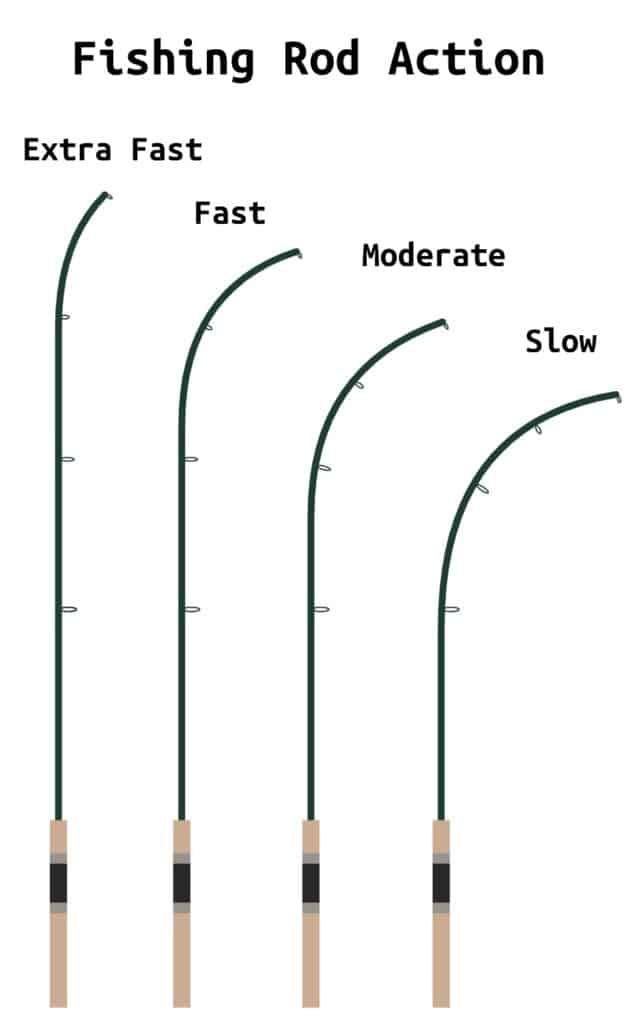
The faster the action, the more sensitive the rod will feel. The slower the action, the more casting distance you can get (the rod will feel like it whips more when you cast).
Sensitivity isn’t a major concern when trolling. Moderate actions are a generally preferred because they put additional ‘give’ in the system so when a big fish strikes your bait, there’s less of a chance to snap the line.
Check out our article on fishing rod actions for even more information.
Portability
Portability is an important factor for any fishing pole. Anglers purchasing a fishing rod should consider how they are going to transport the rod. Ensure the length rod will fit in your boat or vehicle. Seven foot rods will fit in most vehicles but anything above 7’6″ may not fit in boat rod storage or smaller vehicles. Additionally, think about getting a 2 piece rod if portability is a major concern.
Handle Material
Rod handle feel is an important factor to consider when picking a fishing rod. Common handle types are full cork, partial cork, rubber shrink tube, cork tape, or EVA foam. Rubber shrink is usually considered a more budget option, whereas full cork feels better to grip and handle. Some people consider foam easier to grip when wet.
Rod Butt Style
Trolling rods come with two types of rod butts, bent and straight. Bent rod butts are meant to stay in the rod holder for trolling and fighting huge fish. These are usually seen on heavy duty, short rods with roller guides. Straight rod butts are better for fishing where the angler takes the rod out of the rod holder to fight the fish.
Rod Guides
Rod guide material is important because lower quality materials are heavier and will rust quicker and could potentially fail.
The highest end rods have titanium or silicone carbide (SiC) rod guides whereas middle end or budget rods will have some variation of aluminum oxide or stainless steel.
Higher end rod guides are made with lighter materials with lower friction that will either rust slower or not at all. Less expensive rod guides are heavier and will succumb to the elements more quickly.
Super heavy duty trolling rods commonly come with roller guides instead of the standard ring guides seen on most fishing rods. When fighting huge fish, there is a massive amount of friction between the line and the rod guides. With ring guides, this friction could cause line breaks. Roller guides allow the line to roll across the guides with minimal friction. Make sure to rinse and lubricate roller guides after each use.
For additional information on rod guide considerations, check out our article that explains fishing rod guides in detail.
Rod Material
Rod blank material affects rod strength and how the fishing rod deforms during casting or reeling in a fish. Common rod materials are graphite, fiberglass, and composite. Check out our deep dive on rod blanks for more information.
Graphite
Graphite (or carbon) rods have incredible sensitivity in lightweight packages. They are great for detecting subtle fish strikes. Graphite rod disadvantages are that the rods can be a little weaker than the other options and more susceptible to breakage, especially around nicks or scratches.
Fiberglass
Fiberglass is strong, durable and flexible but weighs more than graphite. They are less sensitive than the other types of rod materials. Fiberglass rod blanks are generally preferred for trolling because fiberglass better handles the stresses of being bent for extended periods of time and is less likely to break than a carbon blank rod.
Composite
Composite rod materials are a mix of graphite and fiberglass that seek to have the light weight and sensitivity of graphite rods with the strength of fiberglass rods.
Reel Seat
Reel seats are the component where the fishing reel is secured onto the fishing rod by tightening a locking nut. The basic parts of a reel seat are the body, hood, locking nut, and barrel threads. Common reel seat materials are either graphite or aluminum which are both lightweight, corrosion resistant materials. Reel seats are sized to match the power of the rod. For example, a reel seat on an ultralight fishing rod won’t fit a massive 10000 size spinning reel.
Most freshwater applications utilize fully graphite reel seats due to graphite’s light weight. For heavier duty saltwater applications, reel seats are commonly upgraded to machine-grade aluminum for increased strength. For targeting the largest fish on the planet, the complete rod butt and reel seat can be aluminum for maximum strength.
Maintenance and Care
Maintaining your fishing rod ensures its longevity and performance. After each use, rinse it with fresh water to remove dirt and debris, especially if you’ve been fishing in saltwater. Dry it thoroughly before storage to prevent rust and corrosion. Occasionally check for any signs of wear or damage. Store your rod vertically or horizontally on a rack, avoiding extreme temperatures or direct sunlight.
Explore our ultimate guide on fishing rod maintenance and care for comprehensive insights into maintaining your trolling rods, avoiding common causes of damage, and mastering preventative strategies to ensure your gear remains in prime condition.
Trolling Rod Frequently Asked Questions
What type of rod is best for trolling?
Conventional rods with fiberglass or hybrid rod blanks are considered the best for trolling. Fiberglass handles the stresses of being bent over for extended period of times better than carbon blank rods. Lengths vary between 5’6″ and 10′. Shorter, heavy duty rods are better for targeting massive fish like tuna and marlin, whereas longer rods are used to help keep trolling spreads separated or for specific techniques like downriggers where it’s important for a long rod to take up the slack once a fish strikes and releases the downrigger.
What reel to pair with trolling rod?
Trolling rods are best paired with conventional reels. Conventional reels have the largest spool capacities which is important to get baits to the right depth. These reels also commonly have heavy-duty drag systems and additional features like line counters which all help when trolling for fish.
What strength fishing line for trolling rods?
Trolling rods can use a wide range of fishing line strengths. 20 to 25 lb braid is a great option for freshwater trolling for walleye and salmon. Saltwater anglers should use anywhere from 40 to 130 lb braid depending on target fish species. Be sure to match the strength of the line to the size of the target fish. Smaller fish like tuna or mahi mahi can work on 40 lb braid whereas huge fish like marlin should use over 100 lb test line.
What type of guides for trolling?
Trolling rods come with either roller guides or ring guides. Roller guides are small wheels that roll with the line and have minimal friction which can be important when reeling in massive fish. Ring guides are perfectly fine for trolling for small to medium sized fish. The general recommendation is to use a roller guide rod for targeting huge fish like tuna or marlin.
What is the best material for a trolling rod?
Trolling rods with fiberglass or composite fiberglass and carbon are best. Fiberglass blanks handle the extended periods of being bent over better than carbon due to their increased strength and material properties. Pure carbon blanks are much more likely to break than fiberglass blanks when used for trolling. The primary selling points for carbon blanks, light weight and sensitivity, are not especially important for trolling.
Can you use a spinning reel for trolling?
Spinning reels can be used for trolling but may have limitations in spool capacity, drag rating, and limited depth control functionality. Larger size spinning reels, like 4000 series or higher, are recommended because they will have the spool capacity and drag strength to handle the requirements of trolling.
Is mono or braid better for trolling rods?
Braided fishing line is preferable for trolling because it has significantly smaller diameter for the same strength line when compared to mono. Braided line can be cast further and also has less tendency line twist than mono. Trolling anglers may use heavy duty line, and the ability to fit more braid than mono on the reel spool is an important consideration.
Since braid has very little stretch, many trolling anglers add a “top shot” which is 50-150′ of mono to their spools to put some give in the system. This adds a little bit of stretch so that when a fish strikes a trolling spread there is some built-in shock absorption that reduces the chances of losing fish.

Written By: Andrew Juran
Andrew is a seasoned angler with over 25 years of experience fishing across the United States. He has caught hundreds of fish using various techniques and mentored many in the art of fishing. An advocate for sustainable fishing, Andrew is an active member of the Coastal Conservation Association, an organization committed to marine conservation.
For frequent fishing tips, behind-the-scenes looks, and real-time catches, connect with Andrew on Instagram
